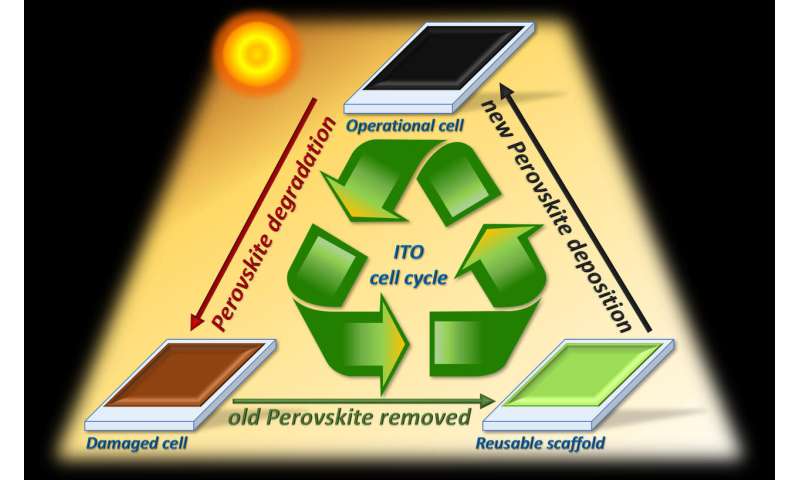https://phys.org/news/2020-11-method-degraded-perovskite-solar-cells.html
The triple oxide mesoporous indium tin oxide perovskite-based solar cell structure.
Credit: Avi Schneider.
A team of researchers at the Hebrew University of Jerusalem has developed a technique for producing recyclable perovskite used in solar cells. In their paper published in Proceedings of the National Academy of Sciences, the group describes their technique and the efficiency of the solar cells after they have been recycled.
As much of the world seeks to find greener energy sources, wind, hydro, geothermal and solar have been found to be the most promising. Of these, solar has become the most prominent for widespread small use applications (such as on rooftops). But despite much effort, converting small-scale operations to solar has proven to be difficult due to its cost compared to traditional sources. In recent years, solar has also come under scrutiny due to its less-than-green fabrication attributes—production of solar cells is "dirty" and they degrade over time, which means they wind up in landfills at some point.
So scientists have been looking for other materials to make them. One of the most promising is perovskite. Unfortunately, perovskite solar cells degrade, as well, and because of the way they are made, (the degrading perovskite is situated between other material layers) it is difficult to recycle or upgrade them. In this new effort, the researchers have developed a new way to build perovskite-based solar cells that allows for swapping out the perovskite once it starts to degrade—without losing efficiency.
The new technique by the team involves using screen-printed, three-layered all-nanoparticle networks as rigid frameworks for building cells bases on perovskites. Such frameworks allow the perovskites to percolate in a way that leads to photoactive networks. The final result is a substrate made of porous conductive oxide layers which are separated by an insulator. The design results in a perovskite layer that is easy to remove and replace.

A scheme of the recycle process, which is unique for the mesoporous indium tin oxide perovskite-based solar cell.
Credit: Avi Schneider.
Recommend this post and follow
Sputnik's Orbit
https://disqus.com/home/forum/thesputniksorbit-blogspot-com/



No comments:
Post a Comment